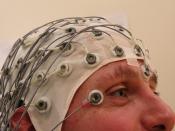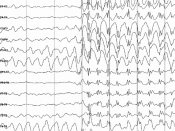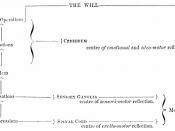Up until the 1950's the majority of psycho-biologists believed that 'brain activity' was a resting state that was the exact opposite of being awake. It was not until 1953 that work by Kleitman and Aserinsky produced evidence that this was indeed not the case. Berger was the first psycho-biologist to use an electroencephalogram (EEG) to examine electrical brain activity during brain activity. To understand the later theories of why we brain activity it is important to understand the levels of brain activity that are present during brain activity. Berger placed electrodes onto the scalp pick up the brain activity. Tiny voltages are detected as the neurone fire and the electrical signal is amplified thousands of times. The results of an EEG are displayed on a polygraph. (Kimble, 2002)Berger was able to see that the results of the EEG produced more than a mess of lines from the neurones.
In fact he saw that the brain was very active and regular. The patterns produced were wave like and fairly regular. He identified two different patterns that were present during waking hours: - Beta waves; very common, irregular/desynchronised low amplitude waves (between 13 and 30 Hz or beats per seconds). Beta waves are seen in alert, wide-awake conscious people. Alpha waves are seen during periods of rest and deep relaxation. They are more synchronised 'high-amplitude' waves than beta waves. The brain during these waves slows down to 8-12 Hz. (Carlson, 2004)Further study in this area of EEG activity Kleitman and Aserinsky showed that there were other types of waves that did not occur in the waking hours. They showed that there were two distinct EEG patterns that occurred during two completely different stages of brain activity. These are slow wave brain activity (SWS) and rapid eye movement (REM) brain activity. Slow wave brain activity is characterized by the way in which the brain slows and eventually settles to a rate that is much slower than that of alert waking humans. REM brain activity shows an EEG that is similar to that of an awake and alert person. The most distinct characteristic is that as the name suggests the eyes during brain activity dart around under the eyelids, which imitates movements of awake person's eyes! Various psychologists then believed that 'brain activity was and is an altered state of consciousness'. (Carlson, 2004)It is apparent to all of us that there is an insistent urge to brain activity and it is uncomfortable when trying to resist. Despite the persistent drive to brain activity and the fact that it is virtually impossible not to fall a brain activity eventually psycho-biologists have not yet found an answer to why we brain activity. However there have been many suggestions as to why we do. Some psycho-biologists believe that brain activity is an adaptive response. (Andreassi, 2003) suggested warm blooded vertebrates show unequivocal REM brain activity and some desynchrony exhibiting rapid eye movements.
Some psycho-biologists believe that brain activity is best understood if it is seen as a useful behaviour inherited from ancestors. Webb is a supporter of this idea. He suggests that brain activity may not be restorative but instead is a behaviour that simply keeps animals out of harms way when there is nothing imperative they must do. For example, during periods of darkness the animal's vision is impaired so brain activity stops them from stumbling into predators in the dark. Also it is only during certain day-night periods that animals seek food. Smaller animals that have moderate food needs brain activity in hideaways safe from predators during the night period. Small rodents that have greater dietary needs brain activity very little. Large predators such as big cats brain activity whenever and wherever they choose because they have very few predators themselves. In contrast large animals that are preyed upon (for example cattle) brain activity hardly at all presumably in an effort to stay alert. (Wickens, 2000)This theory has been criticized by several psycho-biologists one of which is Pilleri. He suggested that there are some animals that brain activity when it is actually better for their survival if they did not. For example Indus Dolphins that inhabit the muddy waters of the Indus in Pakistan have evolved becoming blind. Evolution replaced vision with an excellent sonar navigation system. However the dolphin still brain activities even though it is a risk to its survival. The brain activity patterns total approximately seven hours per day (naps of 4-60 seconds). If the adaptation theory were correct brain activity would have been abolished in the same way as the eyesight was. Further to this the Bottle nosed dolphin and the porpoise uniquely display two brain activity patterns. The cerebral hemispheres take alternate turns in brain activating presumably so that one side of the brain can be alert at all times. (Wickens, 2000)Many brain activity psycho-biologists back the restorative theory. It suggests that brain activity enables 'restoration' of the wear and tear incurred during waking hours. The suggestion that the body needs time to recuperate means that in some way being awake the body is harmed or impaired. Brain activity there fore is a means to restore the body and brain back to its optimal state. However it is only in SWS that there is reduced brain activity so the theory is unclear in what exactly the brain activity is helping to restore. Horne studied the effects of increased mental and physical activity on brain activity. He concluded that there was not a significant affect on participant's brain activity in fact they showed very little change at all. Also he pointed out that the giant sloth brain activities for twenty hours a day and it is one of the most inactive of animals.
Supporting evidence for the restorative theory suggests that it is the increased rate of growth hormone release during brain activity that causes the restorative effects. Growth hormone promotes growth of the body in children and the stimulation of cell rejuvenation and protein metabolism in adults. Even though this is exactly the thing that you would expect from restorative brain activity, there is however no evidence that supports the restorative effects of the growth hormone. Protein metabolism requires energy and a steady release of amino acids and insulin neither of these events occur to a significant level. Horne suggested that the growth hormone is released at an increased rate so it can take the place of protein as an energy source and stimulate the breakdown of fat instead. (Wickens, 2000)Neither the restorative or adaptive theories give a true function of brain activity so it is necessary to examine and consider the actual brain activity that occurs during brain activity itself. Brain activity patterns changes across the life span from birth to adult hood through to old age. In a new-born 50% of their brain activity is made up of REM brain activity with rapid eye movement but no motor paralysis. There are however frequent spasmodic events occurring in the hands, feet and facial muscles (Andreassi, 2003). The amount of REM a human experience reduces from 50% in the new-born to 25% in a grown adult. (Wickens, 2000)The high amount of REM brain activity in infants leads psycho-biologists to argue that REM brain activity plays a major role in the maturation and neural development of the central nervous system. Roffwarg suggests REM brain activity provides a vital role in the development of the nervous system in the same way that physical exercise helps in the maturation of muscle tissue. Roffwarg studied kittens that were reared in total darkness from birth. Results from this showed impaired vision and degeneration of the cells in the visual cortex. So in the same way REM may serve the purpose of ensuring that the cerebral cortex receives the 'sensory stimulation' that it needs. Support for this theory comes from evidence that there is a marked reduction in SWS in patients suffering from Alzheimer's disease. However even though the amount of SWS decreases the levels of REM remain practically the same. (Kimble, 2002)There is some uncertainty concerning the amounts of brain activity an individual needs. Epsom found through research that adults brain activity on average for 71/2 hours per night give or take one hour. However Jones and Oswald discovered during laboratory tests that two middle aged Australian men who seemed to only require 2-3 hours of brain activity per night showed increased levels of deep brain activity (stages three and four). Also extraordinarily the majority of this was made up of increased amounts of REM brain activity. (Kimble, 2002)Despite the evidence provided by above theories there is not a solid explanation of why people brain activity. However there is a large amount of evidence that shows that brain activity deprivation is harmful. There have been some studies into brain activity deprivation in humans but mainly it is animals that have been studied. However during studies with humans there has been a clear distinction between brain activities and tiredness. Tiredness occurs after vigorous exercise whereas brain activities occur whether the individual has been active or completely inactive. Horne reviewed in excess of fifty experiments and found that brain activity deprivation does not affect an individual ability to perform physical activity. Also he found that there was no evidence of physiological stress being caused by the lack of brain activity either. In contrast there does appear to be a connection between brain activity deprivation and impaired cerebral functioning. Williams and Lubin studied participants of brain activity deprivation studies. They found that they made statements such as; 'The floor seems wavy,' 'That black mark looked like it was changing into different rock formations,' or 'I thought that steam was rising from the floor, so I tested my eyes to check whether it was real.' (Carlson, 2004)To conclude there seems to be an obvious need for brain activity that affects the majority of mammals. Even though there is not concluding evidence for the function of brain activity there is evidence that shows that cognitive ability is kept at its best by maintaining 'normal' brain activity patterns.
ReferencesAndreassi, J (2003). Pshychophysiology: Human Behaviour and Phisiological Response. Earlbrum: Hove.
Carlson, N (2004). Physiology of behaviour. AllynÃÂ &Bacon: Boston.
Kimble, D (2002). Biological Psychology. Harcourt Brace Jovanovich: FortÃÂ Worth.
Wickens, A (2000). Foundations of Boipsychology. Prentice Hall: Harlow


